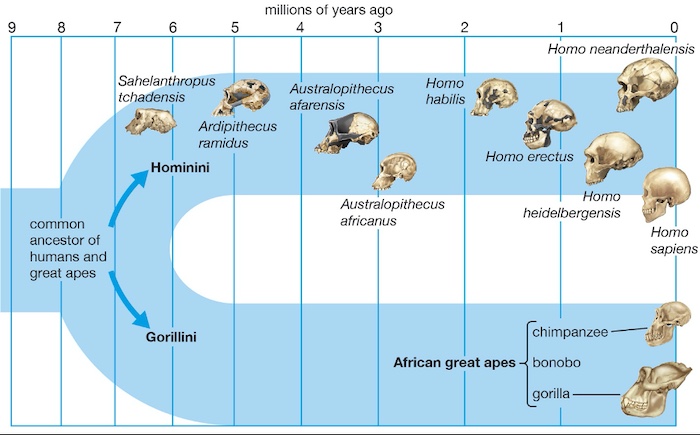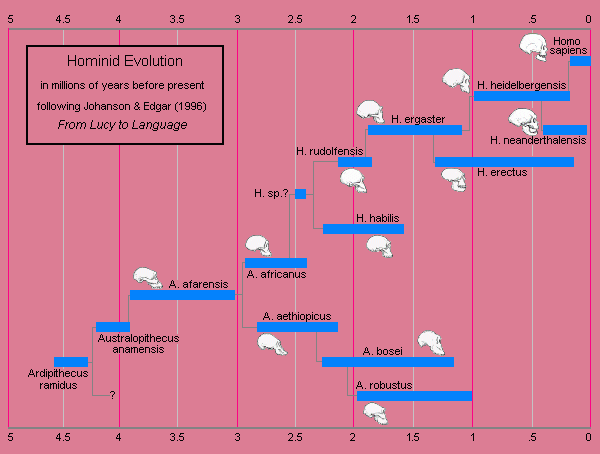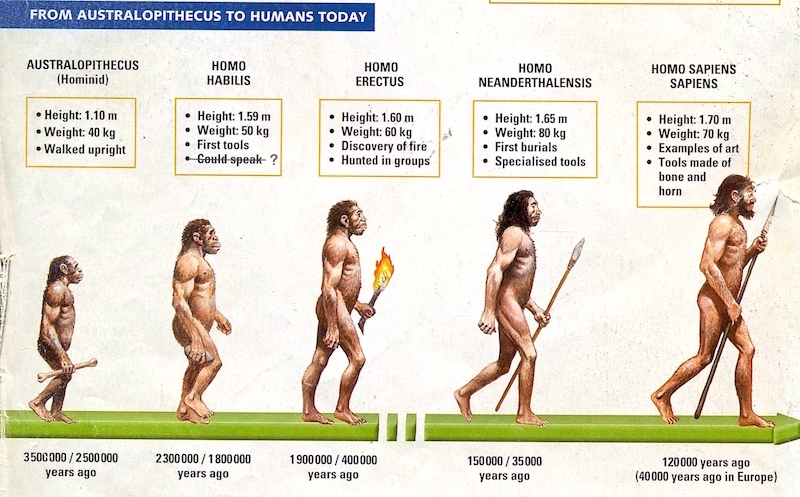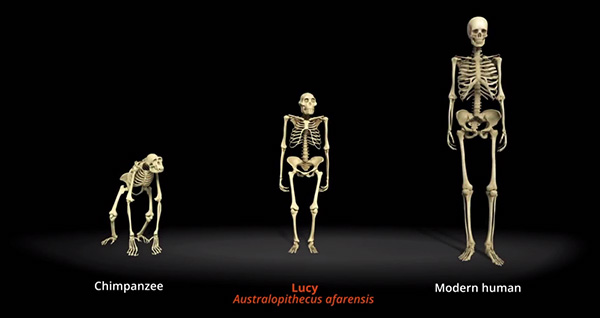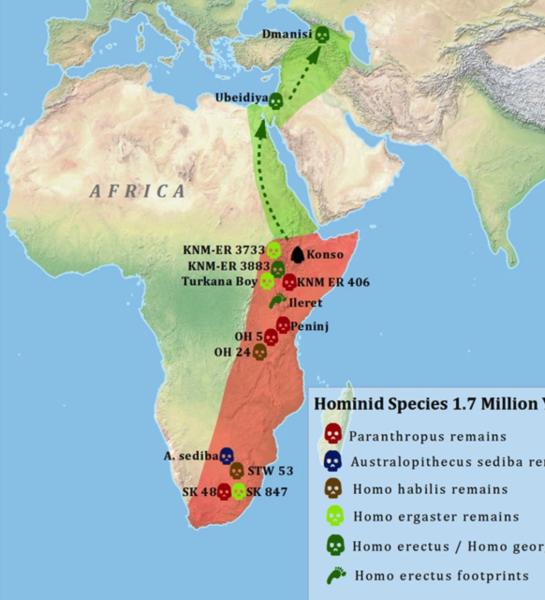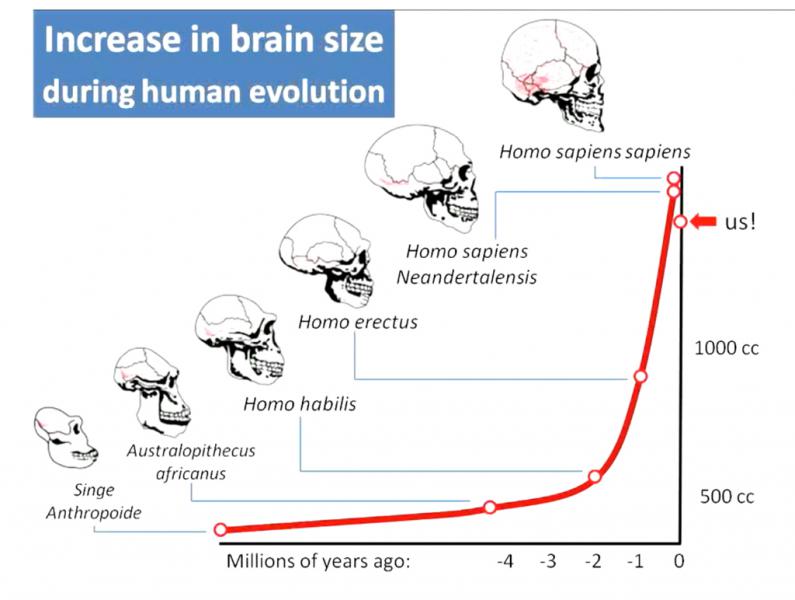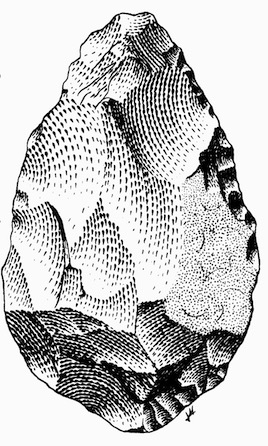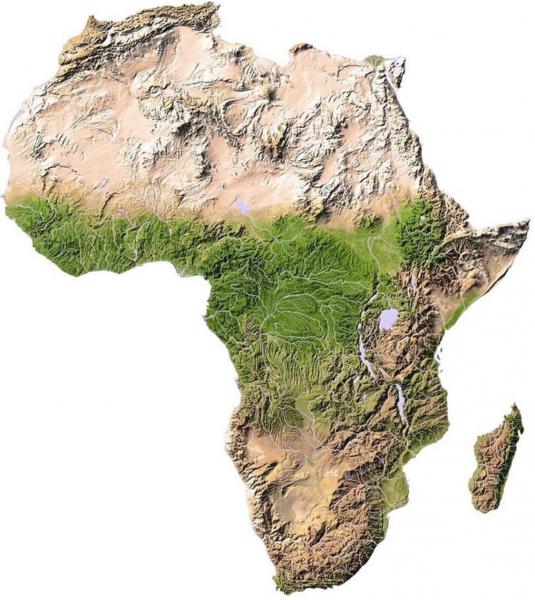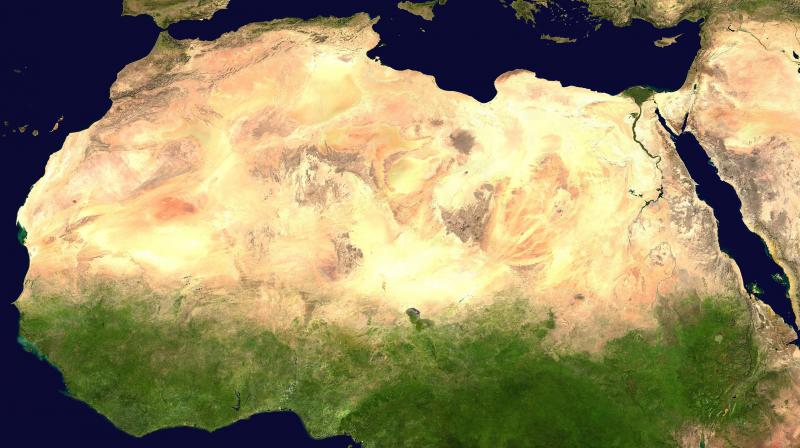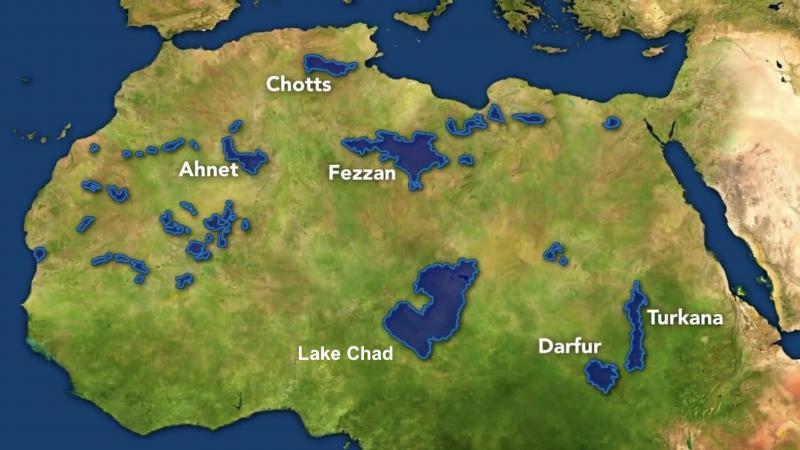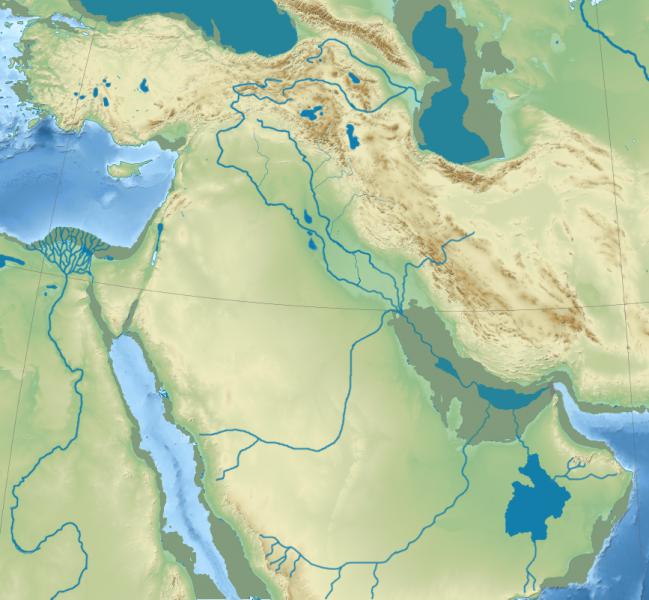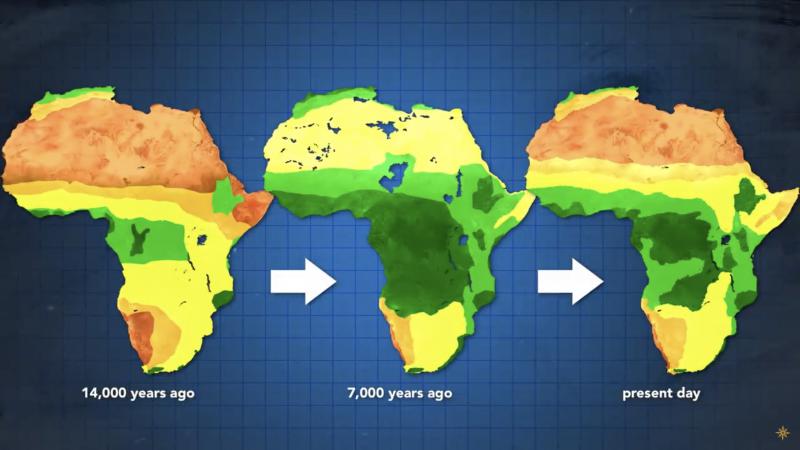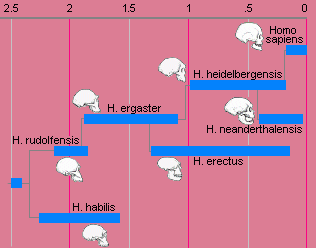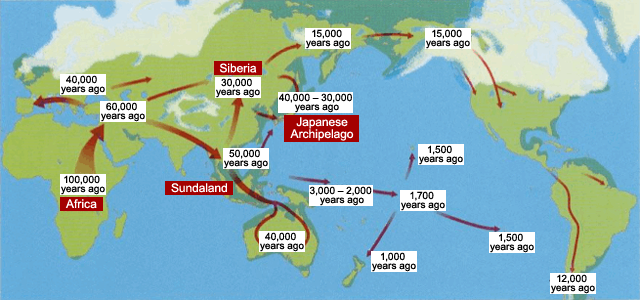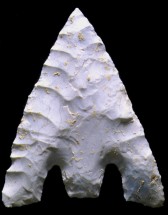- But closer to our time, we revert to BCE (Before the Common Era )
Prequel: Big Bang to Life on Earth !

7 MYa: Ancestors of Man
Around 7 Mya, in Africa, our first ancestors, known as Hominins diverged from chimps, leaving the forest for the savanna. Adaptation to this new ground environment will lead to some physical changes:
- Loss of tail
- Hip changes to promote Bipedal locomotion
- Loss of tree-life attributes: arms shorten and prehensile toe disappears
- Larger brain and smaller jaw changes the skull shape [see REF]
Hominins evolve continuously through many competing species. Around 5 Mya, most Hominins walk fully upright. Then, around 2 Mya, one group starts making and using stone tools. This typically Human behaviour marks the start of our own Homo (human) Genus and earns the species the name "Habilis" (tool-maker). The graph below shows important species discovered over the years.
After Habilis, it will take another 2 million years and several intermediate species before Homo Sapiens [Modern Man] appears. For a quick summary on human evolution, click HERE, Nature.com.
Theory of Evolution
The concept of "evolution" - that species could disappear to be replaced by better ones - started in the mid 1800s. Before that, people assumed that the plants and animals they knew had existed with no change since "Creation." This was based on the Bible which said that, some 6000 years ago, God had created a complete perfect world as a home for his chosen creature Man.But, with the rapid growth of scientific knowledge, this traditional view was challenged. First, geologists calculated that the earth was much older than a few thousand years; estimates ranging from 20 to 400 millions years. Secondly, fossils of extinct species, like dinosaurs and wooly mammoths, were uncovered.
The fact that species had died out could be reconciled with religious doctrine by assuming that the 5 days of creation referred to 5 geological periods, called "deep antiquity"; but the question remained: how do new species arise.
In addition, Man remained a special case since no evidence of his existence before Creation in 4,000 BC had been found.
Then, in 1859, Darwin published "On the Origin of Species" showing examples of natural selection, where individuals with better traits had replaced the others, thus creating new species. However, his examples dealt with birds and turtles - carefully avoiding the "Evolution of Man". This touchy subject was handled soon after by his good friend, Sir Charles Lyell, who published "The Antiquity of Man" in 1863 after visiting sites in France and England confirming that primitive man had existed way before "Creation". With that out of the way, Darwin was free to write "The Descent of Man" (1871).
So, it became accepted that Homo Sapiens had evolved from a more primitive species like an "ape"; but, the discovery of missing links: species showing the progression from monkey to man would require another century.
References:
- Dating the past: Palomar College
- The Antiquity of Man Sir Charles Lyell
- Background to Paleoanthropology James Sackett
- Discovery of Human antiquity Boucher de Perthes
Videos:
- Biology Before Darwin: Crash Course #19
- Geology: Age of Man and the World: Crash Course #20
- Darwin and Natural Selection: Crash course #22
Chronology of "Evolution" theory
- 1841: Fossils in England are attributed to prehistoric giant Lizards (Dinosaurs)
- 1856: First discovery of pre-human skeleton (Neanderthal)
- 1859: Origin of Species, Charles Darwin
- 1863: The Antiquity of Man, Sir Charles Lyell
- 1871: The Descent of Man, Charles Darwin
- 1890: Discovery of Java Man, first specimen of Homo Erectus [ Reference ]
- 1940: Carbon dating, developed at the University of Chicago LINK
- 1960: Discovery in Morocco of oldest Homo Sapiens, dated 300,000 years ago
- 1974: Discovery of a missing link, Lucy, 3.2 million year old bipedal hominin
- 2003: Sequencing technology can now analyze and compare human DNA
- 2016+: DNA analysis settles Polynesian Origins and finds that Sapiens interbred with his cousins (Denisovans and Neanderthals)
View of Evolution.
The evolution of Man is often illustrated by the "March of Progress" below: showing the progressively brainer species that led to us.
In fact, the evolution of our species was much more complex, full of side branches, interbreeding and evolutionary dead ends that anthropologists have tried to reconstruct from isolated bone fragments distributed over several continents and millions of years. More on in this later sections.
![]()
African OriginsGenetics indicates that modern humans and all their hominin predecessors originated in Africa, mainly in the Rift Valley (shown on right), a temperate zone straddling the Equator that would serve as a safe home base during the climatic turmoil of the Ice Ages to follow. The Rift is part of the highlands of East Africa that include the Gorilla forest of Rwanda, and game reserves in Kenya, Tanzania and South Africa. The first Hominins, known as Australopithecines (walking apes), appeared around 5 Mya and looked like small chimpanzees. It took them another 2 million years to develop the first of human attributes: upright motion [ Ref: Human Journey ]. |
Lucy: the first step towards modern Man
Lucy is the name given to a 3.1 Mya fossil of a female Australopithec afarensis discovered in 1974. Only 40% of her bones were present; but this was more than enough to allow a reconstruction. She was small: 1.1 m (3 ft 7 in) tall and weighing 29 kg (64 lb). Her skull was similar to a chimp's and the brain size was about a quarter that of a modern human. But, most significant, her pelvis and femur indicated that she walked upright, a useful adaptation to move efficiently on the ground. This early bipedalism was confirmed in 1976 by the discovery of a set of fossilized foot prints dated to 3.7 Mya in Laetoli (Tanzania).Lucy was a pivotal find and, for many years, represented the missing link between Ape and Man [ Ref. ]. More recently (2010), the skeleton of a male relative of Lucy (Kadanuumuu Man) was uncovered, confirming that the species could not only walk, but run, practically as well as modern humans [Ref].
All hominins have attributes of modern man - like bipedalism - that differentiate them from apes, but the early species are not truly human in that they they lack the intelligence to make and use tools. It takes another million years after Lucy before a new (smarter) hominin, Homo habilis, starts using tools and becomes the first human ancestor worthy of the label "Homo".
References
- Early Man and Ancient History (Facts and Details)
- Our Hominid Predecessors: Human Journey
- Human Evolution Series ( PBS YouTube )
- Human Evolution Fossils ( Wikipedia )
- Atlas of Human Evolution: The Age of Australopithecus
- Laetoli footprints (Wikipedia)
2.6 Mya: Hominins get Smart 
One million years after Lucy, some hominin species develop larger brains and start showing signs of Human intelligence by making stone tools. This early tools-making period is called the and we start including the word Homo (human) in their names, like Homo Sapiens for us.
Because stone tools don't decay like animal bodies [see Skeletonization], it is usually the discovery of these tools, not fossils, that indicate to archeologists where hominins lived and how advanced they were. In fact, knowledge of our Homo ancestors is based on fewer than 100 fossil finds [ Wikipedia ].
The evolution from the first tool user, Homo habilis, to our present day Sapiens is often illustrated by the March of Progress below; but our evolution was much more complex: full of dead ends, "cousin" branches, and interbreeding, so that we can never be sure which species "begat" the next.
- 2.3 Mya:
Homo habilis [ Wikipedia ]
The oldest member of the genus Homo, H. habilis (2.3–1.4 mya) lived in East Africa and is associated with butchered animal bones and simple stone tools. He looked like an ape, about five feet tall and 100 pounds ( appearance ); but his brain was considerably larger than that of his predecessor Australopithecus brain and was also more humanlike. But, whereas previous hominins, had used whole stones to crack nuts, Habilis developed the Oldowan technique; splitting stones with one or two blows to get a flake with a sharp cutting edge. The original stone core could also serve as a scrapper. This may not seem like much, but it was sufficient for his needs: Habilis was mainly vegetarian, only occasionally eating scavenged meat scraped off bones.
References: PBS
- 2 Mya: Homo erectus [ Nature Education ].
Next, a new more "human-like" species appears along-side Habilis in East Africa around 2 Mya. He has a bigger body and brain [ Ref. ] and a modern upright stance which leads anthropologists to call him Homo erectus. Physically, H. Erectus is the first hominin to look like modern man ( appearance ). See also: Palomar College and Nature
More mobile and adaptable than his predecessors, Erectus is able to migrate and survive in different environments. At some point, helped by the periodic Green Sahara effect, Erectus migrates out of Africa through the Nile Valley and the Sinai Peninsula into the Levant.
Recent digs (1991) have shown that Erectus had reached Dmanisi in the Caucasus around 1.8 Mya. Moving further east into Asia, Erectus reached both China and Indonesia around 1.7 Mya.
Ironically, the initial discovery of Erectus, in 1887, will be in Asia, not his real birthplace in Africa.
Note that without fur, clothes or fire, naked hominins, like Habilis and Erectus, could not survive in freezing conditions and were limited to the warm regions south of the 40th parallel. Yet Homo erectus was still able to spread over 3 continents - as shown in green below - and become our most geographically widespread ancestor.
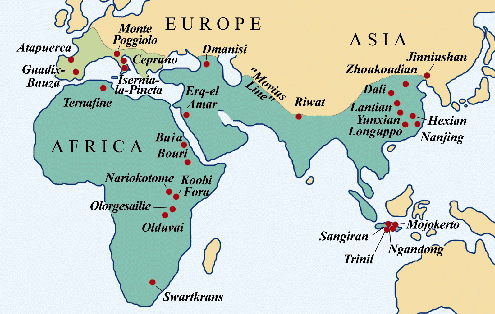
Moving into Europe - light green on the map - would prove more difficult. Entry from the East around the Black Sea was blocked by winter conditions and entry via Spain requires "boats" to cross 10 miles of ocean at Gibraltar. Eventually, Erectus developped the necessary technology and moved into Europe around 1.4 Mya. This is the topic of a later section.
Evolution in Brain Size
During his nearly 1.5 million year presence, Erectus underwent significant physical evolution. Gradually, he grew taller and stockier; but the most obvious changes occurred in the size and shape of the head. This allowed the brain to more than double in size getting close to that of modern man (1400 cc).Our distant cousin, the chimpanzee has a brain size around 400 cc. Erectus started in Africa with a slightly bigger brain, around 600 cc, similar to his predecessor, Habilis; but reaching 1250 cc in his later period in Europe as H. Heidelbergensis. This is shown in the table and illustration below:
| Hominin | Brain size cc. |
|---|---|
| Chimpanzee | 400 |
| Habilis | 600 |
| Erectus (average) | 900 |
| Heidelbergensis | 1250 |
| Homo Sapiens | 1400 |
Shape of the skull
There was also a change in the shape of the skull. Early hominins - like modern apes - have a large jaw and an elongated skull, much like an american football. They also have a pronounced eyebrow ridge and a sloping forehead. Later hominins have smaller jaws and more spherical skulls.Click for of Habilis and Sapiens skulls.
Note also the vertical forehead and protruding chin that characterize Sapiens.
Evolution in Technology
. A bigger brain is not necessarily a more intelligent brain; but Erectus demonstrates increasingly intelligent behaviour in many ways:- Extensive migration, in itself, demonstrates advanced technology: like ability to make rope and fashion traps or shelters, etc... but no physical evidence of these skills survived.
- However, recent discovery of Erectus artifacts on Flores, a remote Indonesian island, indicates that Erectus could make rafts fairly early [ Ref. Erectus the navigator ]
-
The Erectus trademark achievement, was the development of the Acheulean technique for tools like hand axes. It uses repeated well-aimed blows with a stone hammer to achieve sharper bifacial edges; and this requires training, dexterity and patience.
[ See also Stone Tools ]Note: the name "hand AXE" is misleading since these were never designed to chop wood; rather they served as a prehistoric SWISS army knife: used to dig for roots, scrape meat off carcasses, crack open bones, etc.... -
Most important, Acheulean tools are easily recognizable and their discovery is a sure sign that our smart ancestors were present. The technology appears about halfway in the Erectus existence, but it never reaches the far East and is mainly found in Africa and western Europe [ see MAP ].
"Biocultural" Evolution
With better weapons, Man will rise to the top of the food chain without the necessity of evolving claws. Later, with fire and animal skins for clothing, we will be able to survive in northern climates without evolving body fat and fur.
In what follows, we will be less concerned with physical differences between species and more with achievements of our ancestors through acquired knowledge. However, the process still takes time.
The major milestones in evolution include (approx. dates):
- 1.4 Mya: Sharp Acheulean stone tools by Erectus
- 500 Kya: Use of fire and clothing will allow Neanderthals to thrive in northern latitudes
- 50 Kya: a cognitive mutation provides Sapiens with abstract thought, language and art.
- 10 Kya: Agriculture allows modern humans to settle in towns and develop industry
Evolution in Stone Age Technology is described more fully here: Stone Age Technology
Discovery of Erectus
Not only was Erectus our longest surviving ancestor as well as the most widespread; he was also the first Homo species to be discovered, and this was crucial in the general acceptance of Darwin's Theory of Evolution.
But, at the time, the only pre-human skeleton known was that of a 40,000 year old Neanderthal, found in Germany in 1856 ... neither old enough nor ape enough to be considered proof.
Java Man - as the find came to be called became the first piece of evidence for human evolution.
For 30 years, Java Man was our oldest known ancestor. Then, in 1921, similar remains - termed Peking Man - were discovered just north of Beijing. This consolidated Erectus as a widespread species. It also gave rise to the theory that early man had originated in Asia.
It took another 40 years before the African origin of all Hominins was finally accepted. This happened as a result of extensive field work by Louis Leakey and an army of collaborators. [ Ref: Wikipedia, Smithsonian, Facts&Details ].
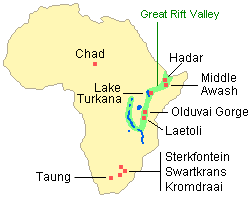
- That year, Mary found the skull of a 1.8 My old hominin with a massive jaw and a skull like a gorilla. The oldest find at the time. This discovery was a sensation, catapulting the Leakeys to world fame.
- The next year, they found remains of a tool-maker they christened "Homo habilis": teeth, a partial skull, hand, and foot bones dated to 1.75 Mya. This was the first solid proof that our Homo Genus originated in Africa (Ref: Nature).
- That same year, Leakey found Erectus remains dating back to 1.4 Mya.
- In the years that followed, more Erectus fossils came to light:
- Older (2.3 Mya) remains were found Ethiopia .
- Turkana Boy, a nearly complete skeleton dating back 1.9 Mya, was found in northern Kenya
- a skull dated to 1.95 Mya uncovered in South Africa.
- What really moved the human origins spotlight to East Africa was the ability to accurately pin an age on the bones the Leakeys and others were uncovering. While the fossils could not be dated directly, volcanic ash layers interspersed between the artefacts, could be dated by the clocklike decay of their radioactive elements.
Erectus "varieties"
Historically, every new find was presented as a different "species". This includes: H. Erectus, H. ergaster, H. rudolphensis, H. heidelbergensis and others shown in traditional evolution trees.
Now, these "old" species are considered to be Erectus variants: Ergaster refers to early versions found in Africa, Dmanisi - the first group to leave Africa -, and Heidelgergensis applies to the latest incarnation which moved north into Europe, adapted to the colder weather and produced the Neanderthals. Ocasionally, Erectus may refer to the larger specimens initially found in Asia.
In conclusion, the evolution of our species was a complex process, full of side branches, interbreeding and evolutionary dead ends, requiring a few million years. But the fact that we did evolve is more important than which group did what or begat which.
End of Erectus
In the East, Erectus does not evolve and survives later only to disappear before the arrival of Homo Sapiens. In China, Erectus lasts until 400 Kya. In Indonesia, Erectus survives longer: skulls first discovered near the Java Man site, were re-dated and found to be about 110,000 years old [ Ref ].
One group, isolated on the island of Flores, survived longest: until the arrival of Sapiens ~ 50,000 years ago. Their remains, tiny in size, were discovered in Lingbua Cave. These "hobbits," as the Press called them, are thought to be descendants of early Erectus navigators who underwent Island Dwarfism over time.
Other References
- Atlas of Human Evolution:
The Age of Homo Erectus
- List of Hominin Fossils ( Wikipedia )
- Lumpers and splitters
- DNA and Evolution, molecular clock
- Interbreeding
- Neanderthals
- Hominin Skulls
2.6 -> 1 Mya: Role of Climate

Central Africa with its combination of rain forest, savanna and highlands was the ideal crucible for the evolution of our successive ancestor species going from apes to hominins to modern Homo Sapiens.
But, in order to leave Africa and succeed elsewhere, Early Man first had to cross the Sahara, then adapt to many different conditions and face periods of extreme climate change.
Here, we consider briefly two distinct climate phenomena which impacted our progress... sometimes for good, sometimes for bad:
- The Sahara Green Periods which periodically allows hominins to move north.
- The Ice Age which figures prominently in our view of prehistory.
Sahara Green Periods
For all of our recorded history, exit from the continent has been blocked by the Sahara, the world's largest arid desert which occupies a third of the continent and forms a 1,000 mile wide barrier all accross the north.However, the Sahara was not always a barrier. Research and exploration has confirmed that the Sahara alternates, in a 20,000 year cycle, from the extreme desert that we know to a lush GREEN savanna and back again. This cycle also applies to the Arabian Peninsula which gets rivers and lakes. The periodic greening opens temporary migration paths out of Africa into Europe and Asia.
During green periods, the Sahara was home to all the animals we associate with Africa: like giraffes, antelopes, elephants and hippos. Rock Art all over north Africa testify to the presence of both animals and Hominins.
The "Sahara" cycle also affects the rest of the continent, as shown on the map below. During arid periods, rainforests south of the Sahara shrink and sources of water such as Lake Victoria dry up. All animals, including our predecessors, would have to change habitats, allowing more adaptable species to emerge.
This cyclic change in habitat may have triggered the evolution of our upright ancestors from tree dwelling apes. Initially, our predecessors had long arms and prehensile toes, attributes well suited to living on trees in forests (dark green on the map). At various times (see LEFT on the map) those forests nearly disappear in favour of savanna (light green) and grassland (yellow). This would give a net advantage to emerging Homo species, with long legs adapted to bipedal motion, who could run fast and far on the savanna.Later, the green periods allowed Erectus to leave the sub-Saharan crucible of emerging species and reach the exit points to the rest of the world: the Sinai to the middle east and the Strait of Gibraltar for Europe.
The Ice Age
The Ice Age, also known as the Pleistocene, started started 3 million years ago and coincides with our whole evolutionary period. It looms large in our view of prehistory as it presents a world covered in glaciers with primitive cave-men fighting mammoths [ Stereotype ].In fact, most of our evolutionary history took place in the tropics, far from snow. It was only in the last 500,000 years that our immediate predecessors, the Neanderthals, developped the necessary skills and tools just to survive a present day winter; and only in the last 40 Kya years that our current species, Homo sapiens, entered Europe and had to contend with snow and ice.
But, contrary to common belief, the Ice Age was not a continuous period of extreme cold; rather, as shown in the graphs below it consisted of periods of extreme cold (glaciations) separated by interglacial periods with temperatures similar to our present day. During the coldest periods, global temperatures dropped by about 9º F. (5º C.) and ice sheets spread out from the poles. Both glacials and interglacials lasted tens of thousands of years.
The charts below show the changes in global temperature over the past 5 million years.
[ Ref. Palomar,
Utah Geo. Survey].
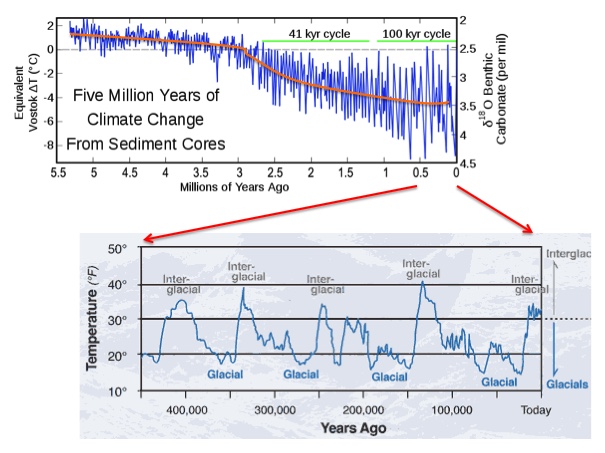
Note: Often overlooked, the Ice Ages also had interglacials much hotter than today (see 130 Kya above ). Recently, fossils of tropical hippos were found near Trafalgar Square [ 2011 Thesis, Image]
The map below shows the situation during the last glaciation: glaciers reached the 40th parallel in America and covered up half of Europe, altogether: 30% of the world's land mass.
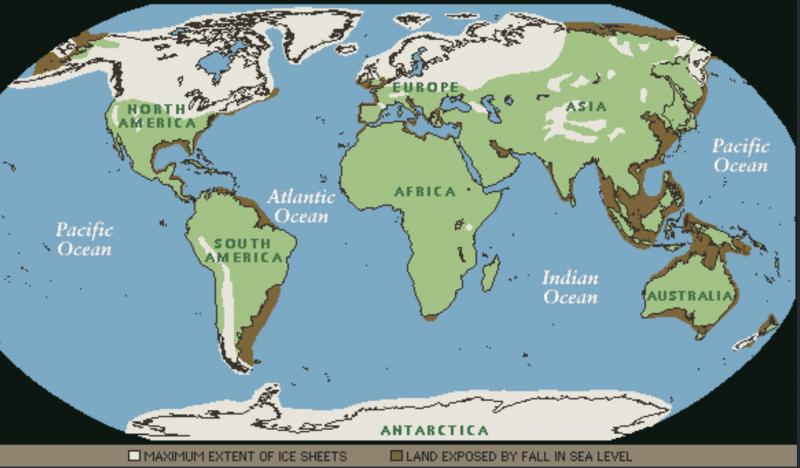
The world ( during glaciations )
In Africa and the tropics, temperatures were basically unaffected by glaciations (Ice Ages) and evolution could proceed unimpeded. In fact, the Ice Ages created bridges which helped Erectus to conquer the world.
Land Bridges
Even though glaciations in the north have little impact on temperatures in the south, they have a huge effect on sea levels all around the world. Glaciations tie up huge volumes of water in continental ice sheets 1500–3000 m thick, and sea levels drop up to 150 m. This creates land bridges between islands and continents which appear in BROWN on the map above: Indonesia is connected to Malaysia, New Guinea to Australia, Siberia to Alaska and England to Europe.We now understand how naked Erectus managed to leave Africa, around 1.9 Mya and reach the Island of Java:
- A green period allowed him to cross the Sahara and leave via the Sinai.
- Tropical weather unaffected by the "Ice Ages" allowed travel to south-east Asia.
- Finally, land bridges gave walking access to present day Java.

Spread of Erectus
Winter
However, migrating north into Europe and Asia (yellow and light green areas above) would take another million years. Not because of Ice Ages but simply because of winter : without fur, clothes or fire, naked hominins could not survive the freezing winter conditions found north of the 40th parallel.Eventually, some late model Erectus (Heidelbergensis) with raft and paddles will manage to cross the Straits of Gibraltar into southern Spain (~1.2 Mya), learn to cope with mild winters and venture north. But their geographical range will then oscillate as Ice Age conditions alternate with interglacials.
During Interglacials, early man will be able to visit England to find tropical animals around the Thames ; but during Glaciations, permafrost would force early man to retreat towards the Mediterranean . All the while, our ancestors will be developping technology for weapons, clothes and shelter. More details can be found by clicking the buttons below.
1 Mya: Erectus to Homo Sapiens 
The next phase in human evolution will place in Western Europe, the light green area on the map below.

Homo erectus is contemporary to other advanced hominins in Europe (Neanderthals et al). Eventually, he disappears around 200 Kya.
1000 Kya,
Homo heidelbergensis :
![]() Intermediate species bridging the gap between H. Erectus and the
Intermediate species bridging the gap between H. Erectus and the
![]() next waves out of Africa: the Neanderthals and Homo Sapiens. [ Wikipedia ]
next waves out of Africa: the Neanderthals and Homo Sapiens. [ Wikipedia ]

By this time, all Human species use FIRE
(700 Kya - 400 Kya )
300 Kya: Neanderthals Almost humans. Found in Europe and Asia Minor [Range]. Developed better (Mousterian) stone blades and started attaching them to wood handles to obtain axes, adzes (useful to hollow out logs) and spears.
- Probably the first to wear clothes: skins and furs, and start migrating towards the frozen north. [ Wikipedia ]
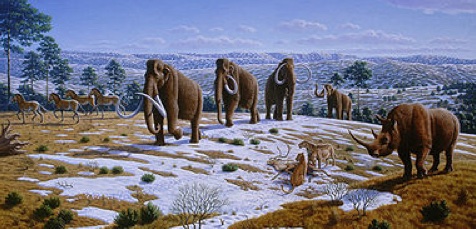
250 Kya: Denisovan Another stocky cousin of the Neanderthals who operated accross East Asia. First evidence of their existence was some bones (part of a finger and later a tooth) found in 2010 in Siberia. Genetic analysis shows that Denisovans interbred with Neanderthals and their DNA has been found in Melanesians and Australian aborigines.
200 Kya: Homo sapiens
- Appears in Africa and evolves along side other humanoids around Ethiopia.
- Around 100 Kya, H. Sapiens leaves Africa and spreads accross the planet.
- Migration proceeds in fits and starts, dependent on the glacial cycles which provide land bridges and ice barriers. Initially, little distinguishes H. Sapiens from the other hominin species. As hunter-gatherers, H. Sapiens moves in groups of 15-30 individuals ranging over areas roughly 100 square kilometers. Encounters with other groups (of Sapiens or other Hominins) would be rare.
74 Kya: Toba Catastrophe
- The largest volcanic explosion in 25 million years deposits an ash layer about 15 centimetres thick over the whole of South Asia. It may have caused a global volcanic winter of six to ten years. Many species become extinct. The explosion is thought to be linked to a genetic bottleneck when the human populations sharply decreased to just 3,000–10,000 individuals.References
- Atlas of Human Evolution: The Age of Homo Sapiens
50 Kya: The Cognitive Revolution
Although early Homo Sapiens appeared identical to modern man, for 150_000 years, his mental abilities were limited - on a par to those of contemporary hominins. He used the same stone tools; had no jewelry and hunting was limited to small animals.
But after 50 Kya, there is evidence of a HUGE change: artefacts found around burial sites become much more sophisticated, including: art (jewelry and drawings), bone tools such as needles and fish hooks, better weapons like harpoons and bows and arrows. This progress is attributed to mutations ( better brain and better voice box ) which allowed the use of language LANGUAGE. This improved creature is often called Homo Sapiens Sapiens.
Armed with these advantages, Homo Sapiens spreads over the globe.
The H. Sapiens migration across the planet is detailed in the Bradshaw's Journey of Mankind video.[ Download to watch off-line ]
- 60 Kya: India
- 50 Kya: Southeast Asia & China
- 40 Kya: Australia
- 40 Kya: Europe where they are known as Cro Magnon. Within 20,000 years, they wipe out the Neanderthals.
- 15 Kya: America via the Bering land bridge and reaches the southern tip by 10 Kya.
[ Note: the Innu are thought to have come accross in a second wave 2Kya ] - Note: Further migration into the Pacific by Austronesians from Taiwan occurs later after the rise of Civilizations
Homo Sapiens Art
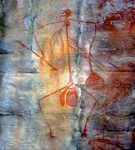
Australia 30 Kya |
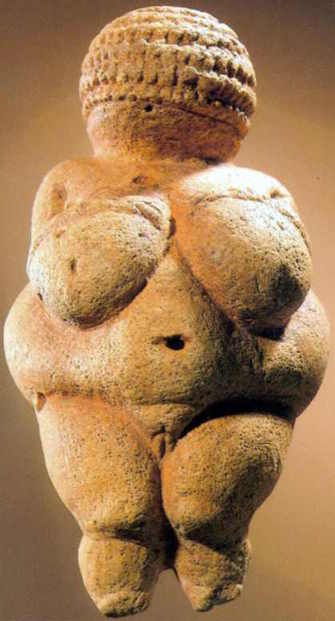
Germany 25 Kya |
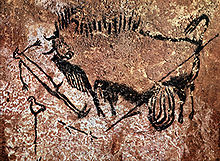
France 16 Kya |
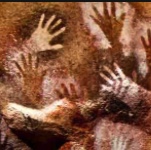
Argentina 9 Kya |
Click images to see bigger.
Wikipedia: Stone Age Art
12 Kya: Mesolithic period
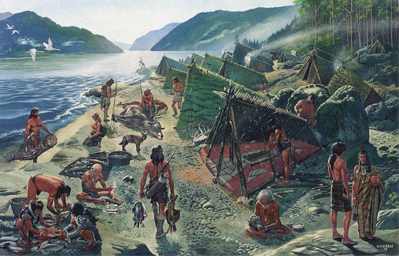
This period saw the development of the axe, the bow and arrow, fishing with spears, hooks, nets and canoes. Probably also domestication of the dog, building of shelters and pottery. The Mesolithic ends with the development of agriculture and the end of nomadic life: the Neolithic period. Dating of these periods is relative because progress occurred at different times in different areas of the world.
Homo Sapiens in the Sahara
Some time after the end of the ice age (~ 10,500 ya), monsoon rains come to the Sahara turning it into a savannah-type environment extending from Mali to Ethiopia. Humans move in, first as hunters, then as herders. They occupy the Sahara for 4,000 years until the rains stop and desert returns. Rock Art throughout the area testifies to the human presence. [Ref1, Ref2. ] https://www.slideshare.net/slideshow/1-sahara-trade-and-empire-introduction-su2014/37520244
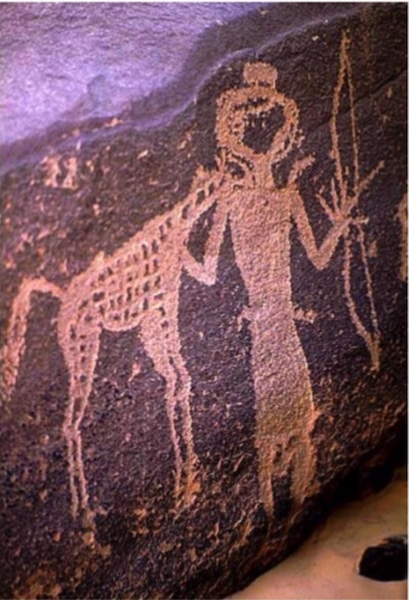 ~ 8 Kya |
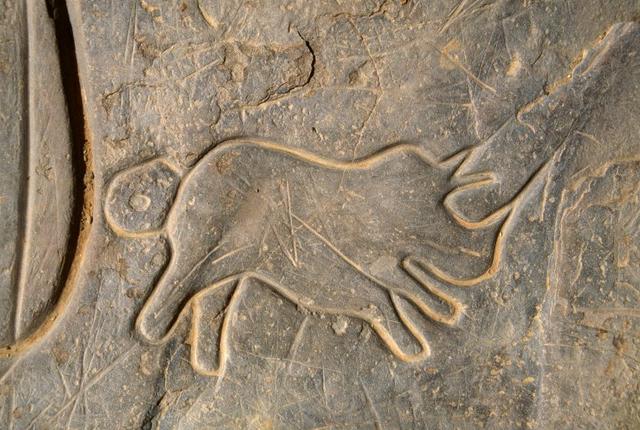
|
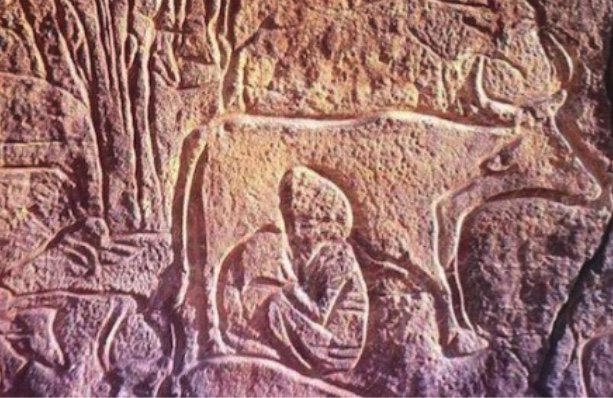 7 Kya |
10,000 ya: Start of Civilization
- farming based on various cereals
- herding: domestication of cattle, goats, sheep, pigs and fowl
- pottery: essential for the storage of grain
- farming tools : sickles, hoes, mortars & pestles
Wheat is the first cereal to be cultivated, followed by barley. Rice comes much later. In the Americas, the crops will be squash, corn and beans.
[ Reference ]
These plants are developped in main 3 areas: the fertile crescent, China and Mexico. Then, the seeds spread rapidly to other areas, like Egypt.
This occurs around:
- 10,000 BCE in Mid East (Jericho) and China
- 7,000 BCE in India and Mexico
- 5,000 BCE in Europe
Farming leads to the creation of villages and cities. Increased food production frees people to become craftsmen and priests. Land ownership creates class hierarchies with chiefs, kings and armies.
Then, industry, commerce and conquest spur invention.
Metals in the Stone Age
Gold and copper are two metals that occur in a relatively pure state as nuggets in nature - think of panning during the California gold rush. Although these metals cannot yet be melted they can be beaten into various shapes. Thus copper scrapers and gold leaf jewelry appear.
5,000 BC: Invention of the WHEEL
4,000 BC: High temperature kilns lead to ceramics and extraction of copper from ore by smelting [ Video ].

- Cuneiform on clay tablets in Mesopotamia
- Hieroglyphs on monuments in Egypt
- The Phoenecian alphabet (phonetic writing) comes later (~1,000 BCE)
3,100 BC: The first Paraoh, Narmer, unifes Upper and Lower Egypt
3,000 BC: Start of Bronze Age;
![]() - Discovery that adding 12% tin to copper
- Discovery that adding 12% tin to copper
![]() - gives a harder metal... which can be molded
- gives a harder metal... which can be molded
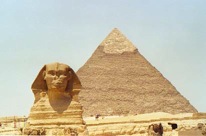
2,500 BC: Cheops builds the great Pyramids at Giza
![]() - Minoan civilization on Crete
- Minoan civilization on Crete
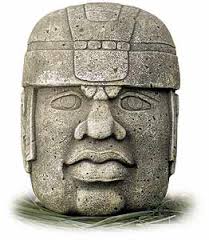
1,800 BC: Shang dynasty & writing system ( pictograms on shells)
1,500 BC: Olmec civilization in Mesoamerica
- The Maya (600 BCE), Aztec & Inca empires occur much later (~ 1,400 CE)
1,200 BC: Iron Age
![]() - Phoenicians emerge as ship builders using cedars of Lebanon
- Phoenicians emerge as ship builders using cedars of Lebanon
![]() - Master traders for the next 900 years
- Master traders for the next 900 years
![]() - Trojan Wars
- Trojan Wars
750 BC: Founding of Rome
![]() - Homer writes the Illiad & Odyssey
- Homer writes the Illiad & Odyssey
500 BC: Classical period of Greece
250-150 BC: Punic wars (Rome versus Carthage)
-> Back to my HISTORY Pages
References:
- Dating Techniques, Early Man And Hominin Dating Techniques, Facts and Details
- Jared Diamond, Guns, Germs and Steel, Wikipedia
- Y.N. Harari, Sapiens: A Brief History of Humankind (2011), Wikipedia
- Atlas of Human Evolution: a 7 million year journey
- Ed. by E. Delson et al Encyclopedia of Human Evolution and Prehistory (2000), 753p.
- Barbara Welker, The history of our Tribe, : Homini (2014)
- Palomar College: Anthropology Tutorials by Dennis O'Neill
- Bruce McEvoy's Human Evolution
- S. Drury Stepping Stones: the Making of our Home World, Open University eBook.

